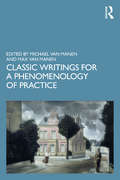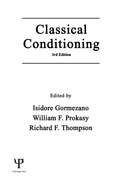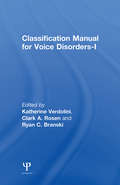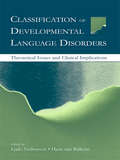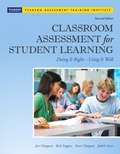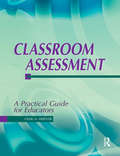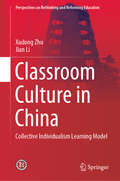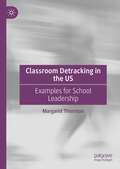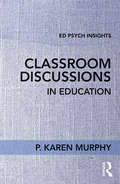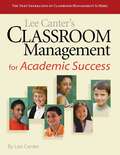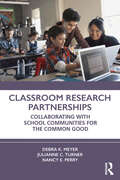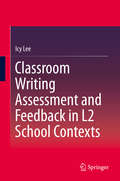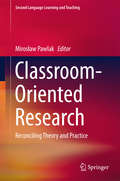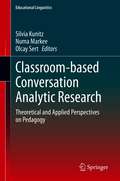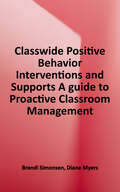- Table View
- List View
Classic Morita Therapy: Consciousness, Zen, Justice and Trauma
by Peg LeVineShoma (Masatake) Morita, M.D. (1874-1938) was a Japanese psychiatrist-professor who developed a unique four stage therapy process. He challenged psychoanalysts who sanctioned an unconscious or unconsciousness (collective or otherwise) that resides inside the mind. Significantly, he advanced a phenomenal connection between existentialism, Zen, Nature and the therapeutic role of serendipity. Morita is a forerunner of eco-psychology and he equalised the strength between human-to-human attachment and human-to-Nature bonds. This book chronicles Morita’s theory of "peripheral consciousness", his paradoxical method, his design of a natural therapeutic setting, and his progressive-four stage therapy. It explores how this therapy can be beneficial for clients outside of Japan using, for the first time, non-Japanese case studies. The author’s personal material about training in Japan and subsequent practice of Morita’s ecological and phenomenological therapy in Australia and the United States enhance this book. LeVine’s coining of "cruelty-based trauma" generates a rich discussion on the need for therapy inclusive of ecological settings. As a medical anthropologist, clinical psychologist and genocide scholar, LeVine shows how the four progressive stages are essential to the classic method and the key importance of the first "rest" stage in outcomes for clients who have been embossed by trauma. Since cognitive science took hold in the 1970s, complex consciousness theories have lost footing in psychology and medical science. This book reinstates "consciousness" as the dynamic core of Morita therapy. The case material illustrates the use of Morita therapy for clients struggling with the aftermath of trauma and how to live creatively and responsively inside the uncertainty of existence. The never before published archival biographic notes and photos of psychoanalyst Karen Horney, Fritz Perls, Eric Fromm and other renowned scholars who took an interest in Morita in the 1950s and 60s provide a dense historical backdrop.
Classic Writings for a Phenomenology of Practice (Phenomenology of Practice)
by Michael van Manen; Max van ManenClassic Writings for a Phenomenology of Practice features examples of newly translated classic phenomenological texts that have been largely forgotten or misunderstood. The writings are unique in that they speak to the practice of doing phenomenological research for the purpose of gaining insights and better understandings regarding aspects of professional practice and ordinary life phenomena and events. Phenomenology does not have to be impenetrable philosophy, dealing with tedious technical issues. Instead, phenomenology may offer relevance, value, and enduring allure to readers and researchers who are engaged with the quotidian life experiences and events of students, patients, clients, friends, and other individuals. This phenomenological approach aims to stay as close as possible to the ordinary events of everyday life: seeing the first smile of a child, feeling compulsive, being humorous, having a conversation, experiencing childhood secrecy, encountering new things—topics that span a manifold of life experiences. In this collection of classic phenomenological writings, each author is thoughtfully introduced, and each text is followed by a conversational descant: a reflection on the phenomenological reflection. The presentation of these classic writings and their reflections aims to show us what it means to do phenomenology directly on the phenomena that we live—thus asking us to be attentive to the fascinating varieties and subtleties of primal lived experiences and consciousness in all its remarkable complexities. This book is relevant for scholars and students who are interested in human science research and the origins and practices of the phenomenological method.
Classical Conditioning (Century Psychology Ser.)
by Richard F. Thompson Isidore Gormezano William F. ProkasyFirst published in 1986. This book is devoted to behavioral, neurophysiological, and neurochemical methods and findings in classical conditioning. It is devoted to a set of model Pavlovian, or classical conditioning, preparations in the rabbit. Although primary emphasis has been placed on the nictitating membrane response (NMR), the set includes, in addition, eyelid, eyeball retraction, jaw movement, and heart rate responses.
Classics in the Social and Behavioral Sciences
by Adma J. D'Heurle Robert C. TashClassics in the Social and Behavioral Sciences
Classification Manual for Voice Disorders-I
by Katherine Verdolini Clark A. Rosen Ryan C. BranskiTo date, there are 300 disorders associated with voice, but until now there has never been a published reference manual that classifies these disorders. Borrowing from the successful organization schema of the American Psychiatric Association’s Diagnostic Statistical Manual (DSM), the Classification Manual for Voice Disorders-I provides the framework for classifying voice disorders using the following criteria for each disorder: essential and associated features; vocal impairment; clinical history and demographic profile; course and complications; medical and voice differential diagnosis; and severity criteria. Classification Manual for Voice Disorders-I is a project of ASHA’s Special Interest Division 3, Voice and Voice Disorders (DIV 3), originally directed by contributing authors Moya Andrews, Diane Bless, Daniel Boone, Janina Casper, Leslie Glaze, Mike Karnell, Christy Ludlow, and Joe Stemple. The text was edited over a period of several years by the authoritative group of voice disorders professionals, including Katherine Verdolini, Clark Rosen, and Ryan Branski. This version represents the fields of speech-language pathology, voice science, and otolaryngology. CMVD-I lists most conditions that may negatively affect the ability to produce voice, based on the most current knowledge. These conditions comprise 30 structural pathologies, 25 neurological disorders, 20 aerodigestive conditions, 13 psychological disturbances, 15 systemic diseases, four inflammatory processes, four traumatic conditions, and five miscellaneous voice disorders. CMVD-I is a must-have resource for professionals who specialize in voice disorders, especially speech-language pathologists and otolaryngologists. The handy organization of this reference makes it a convenient and accessible resource for voice coaches and teachers of singing. It will also be invaluable as a textbook in master’s-level communication sciences programs throughout the world. Proceeds received by Division 3 will be used to support the mission of Special Interest Division 3, which provides continuing education and networking opportunities to promote leadership and advocacy for voice issues from professional, clinical, educational, and scientific perspectives.
Classification and Diagnosis of Psychological Abnormality (Routledge Modular Psychology Ser.)
by Susan CaveHow is psychological abnormality recognised? How many different mental disorders are there, and what are their characteristics? Although there are established guidelines for clinicians working in this area, these have been subject to many criticisms. Exploring how views on this subject have changed over time, and how they vary in different societies, poses important questions about our current practices.This book provides a brief overview of the current definitions and various explanations for psychological abnormality and then focuses on how society diagnoses and classifies behaviour that is deemed to be 'unusual'. Three key areas of the topic are covered: the procedures involved in the diagnosis and classification of mental disorders (such as schizophrenia); research into the history and origins of multiple personality disorder; and a discussion of the implications of cultural variability (including culture-bound syndromes) for the classification and diagnosis of psychological abnormality.Classification and Diagnosis of Abnormal Psychology is an introductory text suitable for students and teachers of the AQA Psychology A2 specification and is also useful for other groups who work in the field of mental disorder, such as nurses, social workers and therapists.
Classification and Diagnosis of Psychological Abnormality (Routledge Modular Psychology)
by Susan CaveHow is psychological abnormality recognised? How many different mental disorders are there, and what are their characteristics? Although there are established guidelines for clinicians working in this area, these have been subject to many criticisms. Exploring how views on this subject have changed over time, and how they vary in different societies, poses important questions about our current practices.This book provides a brief overview of the current definitions and various explanations for psychological abnormality and then focuses on how society diagnoses and classifies behaviour that is deemed to be 'unusual'. Three key areas of the topic are covered: the procedures involved in the diagnosis and classification of mental disorders (such as schizophrenia); research into the history and origins of multiple personality disorder; and a discussion of the implications of cultural variability (including culture-bound syndromes) for the classification and diagnosis of psychological abnormality.Classification and Diagnosis of Abnormal Psychology is an introductory text suitable for students and teachers of the AQA Psychology A2 specification and is also useful for other groups who work in the field of mental disorder, such as nurses, social workers and therapists.
Classification of Developmental Language Disorders: Theoretical Issues and Clinical Implications
by Ludo Verhoeven Hans Van BalkomChapters written by leading authorities offer current perspectives on the origins and development of language disorders. They address the question: How can the child's linguistic environment be restructured so that children at risk can develop important adaptive skills in the domains of self-care, social interaction, and problem solving? This theory-based, but practical book emphasizes the importance of accurate definitions of subtypes for assessment and intervention. It will be of interest to students, researchers, and practitioners in the field of developmental language disorders.
Classifying Psychopathology
by Harold Kincaid Jacqueline A. SullivanScholars question the extent to which current psychiatric classification systems are inadequate for diagnosis, treatment, and research of mental disorders and offer suggestions for improvement.
Classifying Psychopathology: Mental Kinds and Natural Kinds (Philosophical Psychopathology)
by Harold Kincaid Jacqueline A. SullivanScholars question the extent to which current psychiatric classification systems are inadequate for diagnosis, treatment, and research of mental disorders and offer suggestions for improvement. In this volume, leading philosophers of psychiatry examine psychiatric classification systems, including the Diagnostic and Statistical Manual of Mental Disorders (DSM), asking whether current systems are sufficient for effective diagnosis, treatment, and research. Doing so, they take up the question of whether mental disorders are natural kinds, grounded in something in the outside world. Psychiatric categories based on natural kinds should group phenomena in such a way that they are subject to the same type of causal explanations and respond similarly to the same type of causal interventions. When these categories do not evince such groupings, there is reason to revise existing classifications.The contributors all question current psychiatric classifications systems and the assumptions on which they are based. They differ, however, as to why and to what extent the categories are inadequate and how to address the problem. Topics discussed include taxometric methods for identifying natural kinds, the error and bias inherent in DSM categories, and the complexities involved in classifying such specific mental disorders as “oppositional defiance disorder” and pathological gambling.ContributorsGeorge Graham, Nick Haslam, Allan Horwitz, Harold Kincaid, Dominic Murphy, Jeffrey Poland, Nancy Nyquist Potter, Don Ross, Dan Stein, Jacqueline Sullivan, Serife Tekin, Peter Zachar
Classroom Assessment for Student Learning: Doing It Right - Using It Well (Assessment Training Institute, Inc Ser.)
by Jan Chappuis Steve Chappuis Rick Stiggins Judith ArterClassroom Assessment for Student Learning, 2/e is a combination textbook and workbook grounded in research shown to increase student motivation and learning through improved classroom assessment. This user-friendly, practical book is full of real-world examples of what assessment for learning looks like in today’s classrooms. Presented in a format appropriate for use by individuals or collaborative learning teams, the book teaches two central concepts: How to create accurate classroom assessments of all types and how to integrate assessment with instruction day to day, with a focus on student involvement.
Classroom Assessment: A Practical Guide for Educators
by Dr Craig Mertler• Provides detailed information on · the functions of assessment; · how to construct, administer, and interpret the results of teacher-developed assessment techniques; and · how to interpret the results of externally developed instruments such as standardized tests. • Both traditional and newer, alternative assessment techniques are covered. • Advantages and disadvantages of each assessment technique are discussed. • A companion website helps both instructors and students obtain additional information on topics of special interest to them. • Numerous examples of the principles and procedures make it easy for students to understand the material. • The highly practical nature of this book stems from the focus on how assessment intertwines with other everyday activities in classrooms. • Measurement theory and computational procedures that are unlikely to be used by classroom teachers are de-emphasized, producing a textbook that provides comprehensive coverage without being unnecessarily technical.
Classroom Assessment: A Practical Guide for Educators
by Dr Craig Mertler• Provides detailed information on· the functions of assessment;· how to construct, administer, and interpret the results of teacher-developed assessment techniques; and· how to interpret the results of externally developed instruments such as standardized tests.• Both traditional and newer, alternative assessment techniques are covered.• Advantages and disadvantages of each assessment technique are discussed.• A companion website helps both instructors and students obtain additional information on topics of special interest to them.• Numerous examples of the principles and procedures make it easy for students to understand the material.• The highly practical nature of this book stems from the focus on how assessment intertwines with other everyday activities in classrooms.• Measurement theory and computational procedures that are unlikely to be used by classroom teachers are de-emphasized, producing a textbook that provides comprehensive coverage without being unnecessarily technical.
Classroom Behaviour Management in the Post-School Sector
by Mervyn LeborThis book listens to the voices of post-school teachers, managers, theorists, trainees, teacher educators and students talking about the battle against being educated. It analyses models of classroom behaviour management, with examples of theory critiquing practice and practice criticizing theory. The contextual pressures of manageralism, demands imposed by Ofsted, economic survival for institutions based on student numbers, and mandatory attendance requirements have all meant ever-increasing pressures on teachers dealing with students’ violent, disruptive and challenging behaviours, resulting in some highly disordered classrooms in many institutions. Lebor examines the attitudes of stakeholders, including disruptive students, teachers, trainees and managers, and explores a range of issues such as entering the classroom, abuse of computers and technology equipment, overt violence in classrooms, and counter-productive assessment processes, as well as exploring a range of available solutions to the problem. The book will be compelling reading for teachers, teacher educators, trainees, policy-makers, managers in education, but also anyone interested in education and training.
Classroom Culture in China: Collective Individualism Learning Model (Perspectives on Rethinking and Reforming Education)
by Jian Li Xudong ZhuThis book comprehensively examines classroom culture in the Chinese context and develops the model of “collective-individualism-based learning.” Classroom culture plays a fundamental role in constructing students’ learning competencies, perceptions, and behaviors. This book puts forward a collective-individualism-based learning model to explain the classroom culture in China, both past and present. The collective-individualism-based model reflects the individualized learning style of students in Chinese classroom culture, and is characterized by nine symbolic objects; a textbook, an exercise book, a pen, a blackboard, a screen, a computer, a table, a chair, and a platform. In addition to summarizing this approach to learning, the book examines the construction of a classroom culture with Chinese characteristics and argues that the collective-individualism-based model accurately portrays the personal learning style of students in a specific classroom culture that includes particular symbolic objects.
Classroom Detracking in the US: Examples for School Leadership
by Margaret ThorntonThis book offers a comprehensive examination of how school leaders can institute detracking in their school with research-based best practices. Since the 1980s, researchers and educators have called for detracking as an alternative to the common practice of seperating students into classes by supposed achievement levels. In its most basic form, detracking places students in the same classroom regardless of perceived previous achievement. In this book, Thornton focuses on four high-quality detracking programs across the US to provide a roadmap of best practices for school leaders. Focusing on schools in diverse suburban and urban areas, this book will be beneficial to a wide variety of school leaders as well as school leadership researchers. With the effects of the pandemic still felt in schools and the heated debates at school boards across the country, leaders and researchers both need a path forward for equity-focused work. This book helps to provide way finders on that path while also speaking to the need to travel the path in the first place.
Classroom Discourse and the Space of Learning
by Ference Marton Amy B.M. Tsui Pakey P.M. Chik Po Yuk Ko Mun Ling LoClassroom Discourse and the Space of Learning is about learning in schools and the central role of language in learning. The investigations of learning it reports are based on two premises: First, whatever you are trying to learn, there are certain necessary conditions for succeeding--although you cannot be sure that learning will take place when those conditions are met, you can be sure that no learning will occur if they are not. The limits of what is possible to learn is what the authors call "the space of learning." Second, language plays a central role in learning--it does not merely convey meaning, it also creates meaning. The book explicates the necessary conditions for successful learning and employs investigations of classroom discourse data to demonstrate how the space of learning is linguistically constituted in the classroom.Classroom Discourse and the Space of Learning:*makes the case that an understanding of how the space of learning is linguistically constituted in the classroom is best achieved through investigating "classroom discourse" and that finding out what the conditions are for successful learning and bringing them about should be the teacher's primary professional task. Thus, it is fundamentally important for teachers and student teachers to be given opportunities to observe different teachers teaching the same thing, and to analyze and reflect on whether the classroom discourse in which they are engaged maximizes or minimizes the conditions for learning;*is both more culturally situated and more generalizable than many other studies of learning in schools. Each case of classroom teaching clearly demonstrates how the specific language, culture, and pedagogy molds what is happening in the classroom, yet at the same time it is possible to generalize from these culturally specific examples the necessary conditions that must be met for the development of any specific capability regardless of where the learning is taking place and what other conditions might be present; and *encompasses both theory and practice--providing a detailed explication of the theory of learning underlying the analyses of classroom teaching reported, along with close analyses of a number of authentic cases of classroom teaching driven by classroom discourse data which have practical relevance for teachers.Intended for researchers and graduate students in education, teacher educators, and student teachers, Classroom Discourse and the Space of Learning is practice- and content-oriented, theoretical, qualitative, empirical, and focused on language, and links teaching and learning in significant new ways.
Classroom Discussions in Education: Improving Students' Comprehension Through Productive Talk About Text (Ed Psych Insights)
by P. Karen MurphyClassroom discussion is a concept familiar across the field of education and is often employed to support students’ comprehension of text. Edited by a leading expert on classroom discussion, this book situates the topic within the broader context of educational psychology research and theory and brings it to a wider audience. Five chapters describe in detail the different approaches to discussion and provide recommendations for best practices and curricular materials for student success. This concise volume is designed for any education course that includes discussion in the curriculum and is indispensible for student researchers and both pre- and in-service teachers alike.
Classroom Management For Academic Success
by Lee CanterClassroom Management for Academic Success is the first management program designed to specifically address the first priority for today's educator: improving the achievement of all students. This groundbreaking work will take you beyond simply managing student behavior to quickly and effectively establishing an environment that promotes academic success. <p><p> Classroom Management for Academic Success goes beyond the basic concepts of Assertive Discipline® to help you lay a solid foundation for a positive environment in which students will learn free from the distraction of disruptive behavior.
Classroom Motivation: Linking Research to Teacher Practice
by Eric M. Anderman Lynley H. AndermanClassroom Motivation is a comprehensive introduction to the practical applications of research on academic motivation to teaching and learning. Though grounded in theory, the book is uniquely structured around instructional practices that teachers use daily in schools, such as rewards, group activities, academic tasks, student assessment, and parent interaction. This thoroughly revised third edition includes new content on interventions, mindsets, technologies, engagement, and social-emotional learning. Each chapter’s case studies, application exercises, and updated empirical findings will further connect preservice teachers with motivation in practice.
Classroom Research Partnerships: Collaborating with School Communities for the Common Good
by Nancy E. Perry Debra K. Meyer Julianne C. TurnerClassroom Research Partnerships guides academic researchers through the conceptualization, implementation, and dissemination of studies based in school communities. As dynamic, complex contexts, classrooms are rich with the potential for deepening our understanding of teaching and learning processes and creating robust, ecologically valid innovations in education. Designed for both first-time and experienced classroom researchers, this book’s unique framework will move readers toward more responsive, reflexive, and mutually beneficial collaborations. Each chapter presents background on key research decisions, logistical and ethical considerations, and objectives for advancing knowledge and professional practice. Examples are drawn from the research experiences of the authors as well as classroom researchers interviewed for the book, which collectively provides an array of project designs in different cultural settings from early childhood through high school. Researchers from universities, school districts, and nonprofits will find renewed inspiration to set goals that pursue positive and equitable change for the students, teachers, and communities at the heart of classroom research partnerships.
Classroom Writing Assessment and Feedback in L2 School Contexts
by Icy LeeWhile assessment and feedback tend to be treated separately in the L2 writing literature, this book brings together these two essential topics and examines how effective classroom assessment and feedback can provide a solid foundation for the successful teaching and learning of writing. Drawing upon current educational and L2 writing theories and research, the book is the first to address writing assessment and feedback in L2 primary and secondary classrooms, providing a comprehensive, up-to-date review of key issues, such as assessment for learning, assessment as learning, teacher feedback, peer feedback, portfolio assessment, and technology enhanced classroom writing assessment and feedback. The book concludes with a chapter on classroom assessment literacy for L2 writing teachers, outlines its critical components and underscores the importance of teachers undertaking continuing professional development to enhance their classroom assessment literacy. Written in an accessible style, the book provides a practical and valuable resource for L2 writing teachers to promote student writing, and for teacher educators to deliver effective classroom writing assessment and feedback training. Though the target audience is school teachers, L2 writing instructors in any context will benefit from the thorough and useful treatment of classroom assessment and feedback in the book.
Classroom-Oriented Research: Reconciling Theory and Practice (Second Language Learning and Teaching)
by Mirosław PawlakThis collection gathers contributions from scholars from Poland and abroad addressing different facets of research into the processes of foreign-language and second-language learning and teaching as they transpire in a typical language classroom. The book is divided into three parts, which address in turn: research directions and methodology, the findings of empirical research, and links between theoretical considerations and classroom practice. Accordingly, the first part includes papers that examine the role of different research paradigms, put forward concrete research proposals, present innovative data gathering tools or assess the role of such instruments in language teaching. The second part includes reports on original research studies focusing e. g. on teachers' beliefs, the role of lexis and pragmatics, the application of modern technologies, the teaching and assessment of primary school children, and the development of social skills from a cross-cultural perspective. Finally, the third part of the book demonstrates how theory-driven approaches can enhance the effectiveness of instructed second language acquisition.
Classroom-based Conversation Analytic Research: Theoretical and Applied Perspectives on Pedagogy (Educational Linguistics #46)
by Olcay Sert Silvia Kunitz Numa MarkeeThis book presents an international range of conversation analytic (CA) studies of classroom interaction which all discuss their empirical findings in terms of their theoretical and methodological contribution to the field of second language studies and their potential pedagogical relevance. The volume is thus unique in its focus on the theoretical and practical insights of CA classroom-based research and on the impact that such insights might have at the pedagogical level, from teaching to testing to teacher education. Given the growing interest in the pedagogical applicability of CA research, this book is a timely addition to the existing literature.
Classwide Positive Behavior Interventions and Supports: A Guide to Proactive Classroom Management (Guilford Practical Intervention in the Schools)
by Diane Myers Brandi SimonsenA vital classroom management resource, this book shows how to implement positive behavior interventions and supports (PBIS) in K-12 classrooms, regardless of whether PBIS is adopted school-wide. <p><p>The primary focus is universal (Tier 1) support for all students. Practical, step-by-step guidelines are provided for structuring the classroom environment, actively engaging students in instruction, teaching positive expectations, and establishing a continuum of strategies to reinforce positive behavior and respond to inappropriate behavior. <p><p>Numerous real-world examples and learning exercises are included. In a convenient large-size format, the book includes reproducible tools for class-wide PBIS planning and implementation, which can be downloaded and printed for repeated use.

